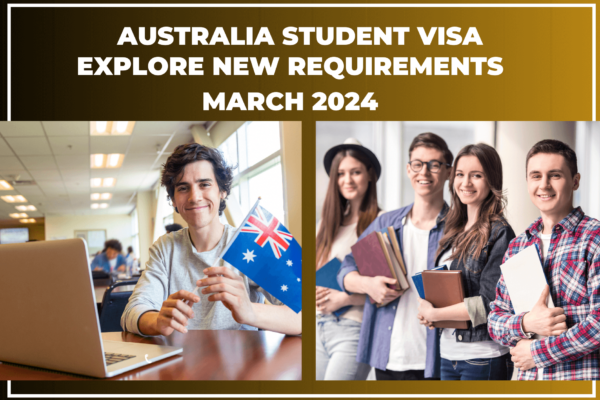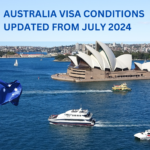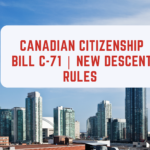
New Australia Student Visa Criteria | March 2024
New Australia Student Visa Criteria : As of March 23, 2024, prospective students considering Australia as a study abroad destination have a new entry point: the Genuine Student (GS) qualification. The Australian government’s Migration Strategy, which was published on December 11, 2023, takes a major step forward with the replacement of the Genuine Temporary Entrant (GTE) criteria for student visas by this revolutionary change. Here’s all you need to know about this historic development if you’re preparing to submit your student visa application on or after March 23, 2024. Accepting Change: The GTE to GS Transition | Australia Student visa The days of confirming temporary intentions with the GTE requirement are long gone. The evaluation of a student’s sincere desire to pursue education in Australia is given precedence in the visa application process with the implementation of the GS criterion, resulting in a significant transition. The strict requirement that students show a commitment to temporary residency is no longer in place, unlike its predecessor. Rather, the various routes that qualified graduates can follow to obtaining permanent residency in Australia are acknowledged by the GS requirements. Reflecting Australia’s changing views on migration and studying abroad, this change represents a substantial divergence from the earlier strategy. This change represents a fundamental break from the previous framework and the introduction of a more comprehensive method for evaluating students’ intentions. The GS criterion better fits the changing environment of foreign education by emphasizing applicants’ real educational goals rather than only requiring proof of a temporary stay. This change has a number of significant advantages, not the least of which is that it acknowledges the increased array of choices available to international students seeking an Australia student visa. The GS criterion accepts the idea that education could be a method of gaining long-term residency rather than limiting people to a temporary stay. This award demonstrates Australia’s commitment to attracting and retaining outstanding talent while also illustrating the evolving nature of international mobility. Furthermore, the GS requirement gives qualified graduates confidence by recognizing the possible paths to permanent residency, enabling them to pursue their educational objectives with a clear knowledge of their future prospects. In addition to improving the overall experience for overseas students, this clarity helps Australia maintain its standing as a friendly and inclusive country for higher education. Essentially, Australia’s approach to evaluating Australia Student visa has undergone a paradigm shift with the switch from the GTE criterion to the GS requirement. Aspiring students can take advantage of numerous opportunities as well as a streamlined application procedure thanks to this new framework, which prioritizes honesty and genuine intent above temporary residency. Pathways to Permanence: Empowering International Graduates The GS requirement’s acknowledgment of post-study alternatives leading to permanent residency is one of its notable aspects; this is especially advantageous for graduates with Australian credentials. This move supports the interests of international students seeking an Australia student visa in addition to being in line with Australia’s broader societal and economic objectives. Graduates are in a good position to fill important skill gaps in the labor force of the country. Combatting Misrepresentation: Identifying Non-Genuine Students For those applying for an Australia student visa in particular, the GS criterion is a useful tool for distinguishing between sincere educational goals and possible abuses of the immigration process. Officials attempt to discern between individuals who are entering the country lawfully and those who are doing so in order to further their own agendas by evaluating a number of indications, including immigration history, adherence to the conditions of the visa, and academic advancement. Navigating the Criteria: What Matters Under GS? Australia Student visa : According to the GS criteria, the evaluation is focused on a number of important elements. These include the applicant’s individual circumstances, documentation of their progress in the selected course, compliance with visa requirements, and other relevant factors. Having a thorough understanding of and attention to these details will strengthen your visa application. The Role of GTE: A Retained Requirement for Student Guardian Visas The GTE standards still hold true for people looking to apply for student guardian visas even though they are no longer applicable to prospective students applying for Australia student visas. This distinction highlights the special duties and responsibilities that come with being a guardian, highlighting the critical role that sincerity has in ensuring the student’s welfare. The authorities renewed their commitment to verifying that guardians have sincere intentions that are in line with the wellbeing of the student entrusted to their care by keeping the GTE requirement for Student Guardian visas. This customized approach highlights the Australian government’s commitment to maintaining the integrity of the immigration system while acknowledging the unique duties of guardianship. In conclusion The change from GTE to GS marks the beginning of a new era for student visas in Australia. It helps to foster a skilled, varied workforce in the nation while also streamlining the application process. (Australia Student visa )Understanding and accepting these changes can help those starting their school adventure in Australia have a more seamless transition and brighter future. Consult the official Australian Government resources for more information and advice on fulfilling the Genuine Student requirement. Stay updated about the latest visa and immigration news – click here for more information.







